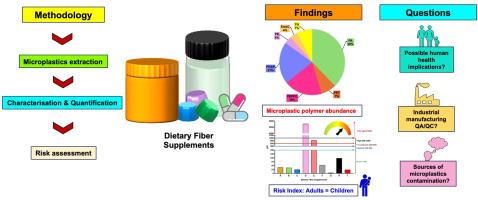当前位置:
X-MOL 学术
›
Environ. Pollut.
›
论文详情
Our official English website, www.x-mol.net, welcomes your
feedback! (Note: you will need to create a separate account there.)
Fibrous foes: First report on insidious microplastic contamination in dietary fiber supplements
Environmental Pollution ( IF 7.6 ) Pub Date : 2024-11-05 , DOI: 10.1016/j.envpol.2024.125248 Logeshwaran Panneerselvan, Haryni Jayaradhika Raghuraman Rengarajan, Raji Kandaiah, Geetika Bhagwat-Russell, Thava Palanisami
Environmental Pollution ( IF 7.6 ) Pub Date : 2024-11-05 , DOI: 10.1016/j.envpol.2024.125248 Logeshwaran Panneerselvan, Haryni Jayaradhika Raghuraman Rengarajan, Raji Kandaiah, Geetika Bhagwat-Russell, Thava Palanisami

|
Regular consumption of health supplements to balance dietary intake has gained popularity worldwide. One such supplement that has gained popularity among consumers is dietary fibers. Microplastic (MPs) contamination in various food products is being reported worldwide. However, there is a paucity of understanding of the occurrence of MPs in dietary supplements. This study addresses this gap by investigating the degree of MPs contamination in dietary fiber supplements. Nine commonly consumed (powder and gummy-based) over-the-counter dietary fiber supplements in Australia were tested in this study. Microscopic examination revealed the presence of MPs fibers and fragments in all the tested products. Further categorization showed that MPs particles were of various colours, including black, blue, red, green, and white. The order of polymer abundance was Polyamide > Polydiallyl Phthalate > polyethylene polypropylene diene > Polyurethane = Polyethylene terephthalate > Polyethylene = Ethylene acrylic acid copolymer. Among the supplements, powder-based samples had higher MPs (at the adult dosage suggested by the manufacturer) than gummy-based product. The average predicted ingestion of microplastics from these supplements (all nine samples) was 5.89 ± 2.89 particles day−1. The dietary exposure for children and adults ranged from 0.1–0.48 and 0.18–4.08 particles day−1, respectively. Based on the microplastic contamination factor (MCF), among the nine samples tested, 69.81% exhibited a moderate level, while 20.76% showed a significant level of microplastic contamination. The polymer risk index (pRi) indicates products with very high and high-risk categories. The possible sources of MPs contamination in the products were studied. To our knowledge, this is the first study to record and quantify the presence of MPs in dietary fiber supplements, which is a direct source of MPs exposure to humans via., ingestion.
中文翻译:

纤维敌人:膳食纤维补充剂中隐匿的微塑料污染的首次报告
定期食用保健品以平衡膳食摄入量在世界范围内越来越受欢迎。膳食纤维是一种在消费者中广受欢迎的补充剂。世界各地都有报道称,各种食品中的微塑料 (MP) 污染。然而,对膳食补充剂中 MP 的出现知之甚少。本研究通过调查膳食纤维补充剂中 MP 的污染程度来解决这一差距。本研究测试了澳大利亚 9 种常用(粉末和软糖)非处方膳食纤维补充剂。显微镜检查显示,所有测试产品中都存在 MPS 纤维和碎片。进一步的分类表明 MPS 颗粒有多种颜色,包括黑色、蓝色、红色、绿色和白色。聚合物丰度顺序为聚酰胺 > 邻苯二甲酸聚二烯丙酯 > 聚乙烯聚丙烯二烯 > 聚氨酯 = 聚对苯二甲酸乙二醇酯 > 聚乙烯 = 乙烯丙烯酸共聚物。在这些补充剂中,粉末样品的 MP (按制造商建议的成人剂量) 高于软糖产品。从这些补充剂(所有 9 个样本)中摄入微塑料的平均预测摄入量为 5.89 ± 2.89 个颗粒-1 天。儿童和成人的膳食暴露量分别为 0.1-0.48 和 0.18-4.08 颗粒 day-1。根据微塑胶污染因子 (MCF) 计算,在检测的 9 个样本中,69.81% 属中等水平,20.76% 显示严重微塑胶污染。聚合物风险指数 (pRi) 表示具有极高风险分类的商品。研究了产品中 MPs 污染的可能来源。 据我们所知,这是第一项记录和量化膳食纤维补充剂中 MP 存在的研究,这是 MP 通过摄入暴露于人类的直接来源。
更新日期:2024-11-10
中文翻译:

纤维敌人:膳食纤维补充剂中隐匿的微塑料污染的首次报告
定期食用保健品以平衡膳食摄入量在世界范围内越来越受欢迎。膳食纤维是一种在消费者中广受欢迎的补充剂。世界各地都有报道称,各种食品中的微塑料 (MP) 污染。然而,对膳食补充剂中 MP 的出现知之甚少。本研究通过调查膳食纤维补充剂中 MP 的污染程度来解决这一差距。本研究测试了澳大利亚 9 种常用(粉末和软糖)非处方膳食纤维补充剂。显微镜检查显示,所有测试产品中都存在 MPS 纤维和碎片。进一步的分类表明 MPS 颗粒有多种颜色,包括黑色、蓝色、红色、绿色和白色。聚合物丰度顺序为聚酰胺 > 邻苯二甲酸聚二烯丙酯 > 聚乙烯聚丙烯二烯 > 聚氨酯 = 聚对苯二甲酸乙二醇酯 > 聚乙烯 = 乙烯丙烯酸共聚物。在这些补充剂中,粉末样品的 MP (按制造商建议的成人剂量) 高于软糖产品。从这些补充剂(所有 9 个样本)中摄入微塑料的平均预测摄入量为 5.89 ± 2.89 个颗粒-1 天。儿童和成人的膳食暴露量分别为 0.1-0.48 和 0.18-4.08 颗粒 day-1。根据微塑胶污染因子 (MCF) 计算,在检测的 9 个样本中,69.81% 属中等水平,20.76% 显示严重微塑胶污染。聚合物风险指数 (pRi) 表示具有极高风险分类的商品。研究了产品中 MPs 污染的可能来源。 据我们所知,这是第一项记录和量化膳食纤维补充剂中 MP 存在的研究,这是 MP 通过摄入暴露于人类的直接来源。


















































 京公网安备 11010802027423号
京公网安备 11010802027423号